
Geranium: Which Varieties Are Best For Your Landscape
Published: 15/07/2024 | Updated: 15/07/2024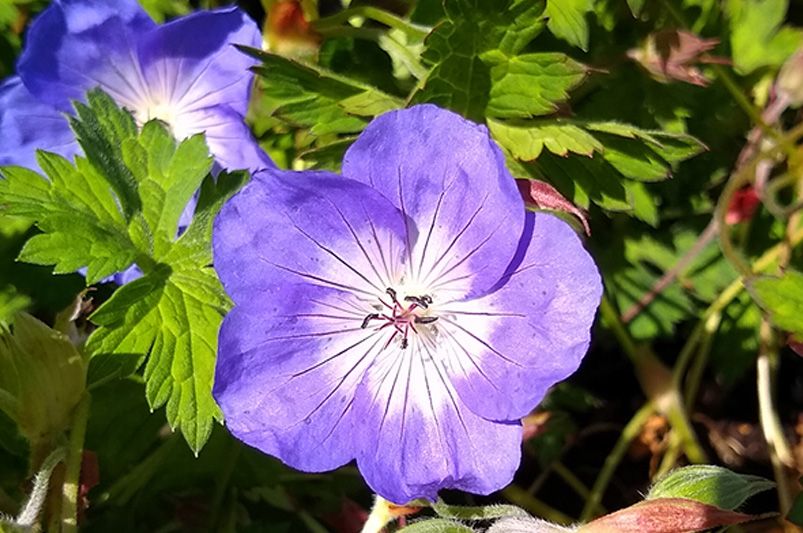
Geranium Plants, also known as Cranesbills, are a genus of annuals and perennials that are found natively are across the Eastern Mediterranean region and other temperate areas. Most usually, the flowers range between white and purple, but there are many varieties that come in shades of blue and pink. They make a beautiful addition to any landscape, with their five-petaled flowers and narrow, pointed leaves. They are also used in floral arrangements and as bedding plants.


In this guide, we’ll walk you through our favourite Geranium varieties to grow, but we’ll also offer you all the essential information you need to grow and care for any Geranium plant. For more gardening and landscaping guides to help you along, check our weekly blogs where we cover everything related to landscape care and tips.
The Best Geranium Varieties to Grow and How to Care for Them
Those 6 varieties are our all time favorites. There’s enough variety between them in color and general appearance that they’re guaranteed to match any taste and garden style.
Azure Rush Geranium
The Azure Rush Geranium is a compact, perennial geranium perfect for smaller gardens or pots. It’s also considered one of the lower maintenance Geraniums. It:
-
Blooms with vivid blue-purple flowers.
-
Compact with a bushy growth habit.
-
Blooms from late spring until fall.
-
Attracts pollinators like bees and butterflies.
-
Grows to a mature height of 15-18 inches and mature spread of 18-24 inches.
-
Grows in USDA hardiness zones 5-8.
-
Is heat and drought tolerant.
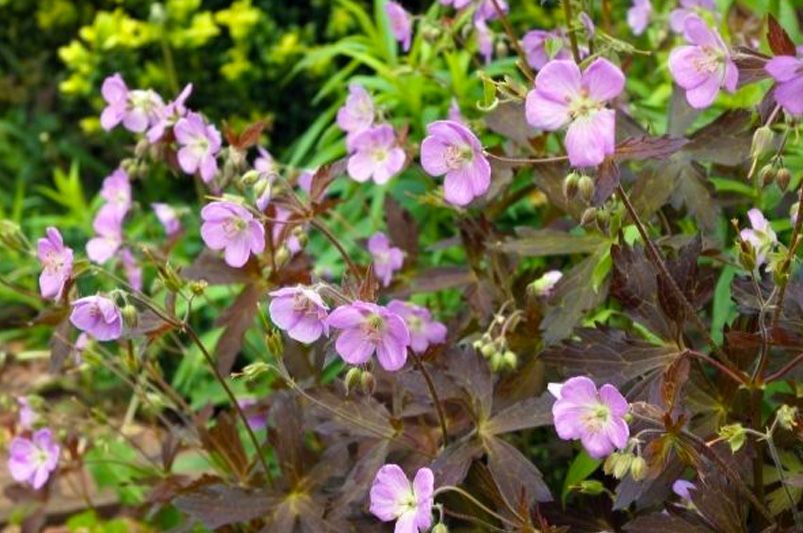
Espresso Geranium
The Espresso Geranium, known botanically as Geranium maculatum ‘Espresso’ is another beloved variety with distinct characteristics. They are:
-
Blooms with pink to lavender flowers.
-
Has a rich chocolate brown colored foliage that contrasts beautifully with the blooms.
-
Grows to a mature height of 12-15 inches and spread of 18 inches.
-
Grows in USDA hardiness zones 3-8.
-
Attracts pollinators like bees and butterflies and even hummingbirds.
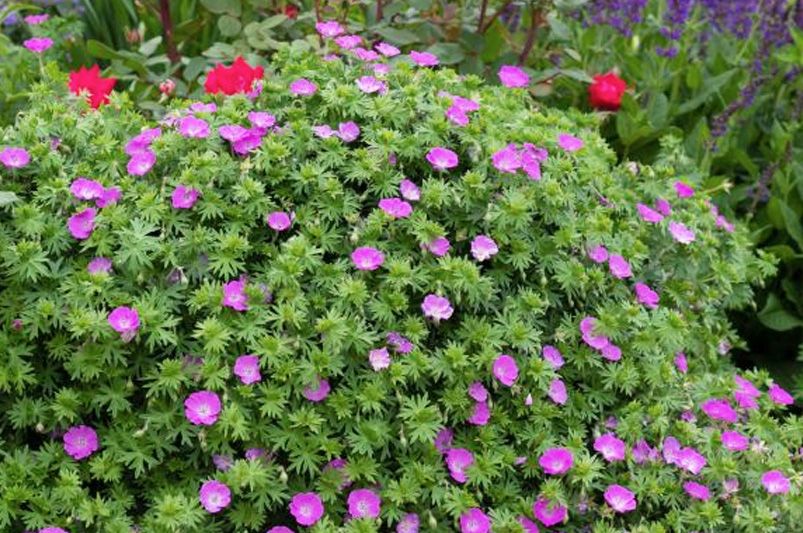
Max Frei Bloody Cranesbill
The Max Frei Bloody Cranesbill, also known as Geranium sanguineum 'Max Frei', is another lovely perennial from the Geranium genus. The plant:
-
blooms with vibrant magenta-pink flowers.
-
Blooms against a rich, deeply-divided, palmate foliage that turns a striking reddish-orange in the fall.
-
Grows to a maximum height of 12-15 inches and spread of 18-24 inches.
-
Is tolerant of various soil types and conditions.
-
Is deer and drought tolerant.
-
Attracts pollinators like bees and butterflies.
-
Grows in USDA hardiness zones 4-8.
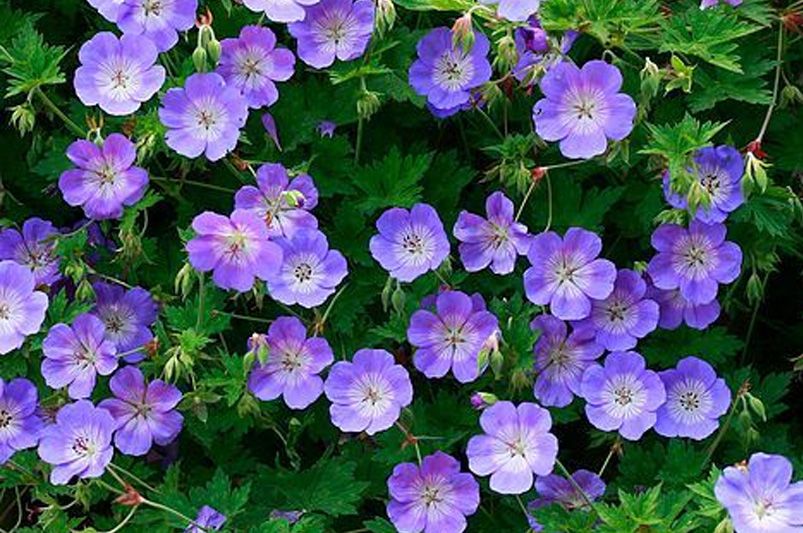
Rozanne Geranium
Rozanne Geranium, known scientifically as Geranium ‘Gerwat’, is one of the most popular Geranium varieties out there. For good reasons! The plant:
-
Blooms with striking violet-blue flowers with dark centers.
-
Blooms against lush green foliage.
-
Has a long blooming period, lasting from late spring until fall.
-
Is heat and drought tolerant and disease resistant.
-
Reaches a mature height of 18-24 inches with a spread of 2-3 feet.
-
Grows in USDA hardiness zones 4-10.
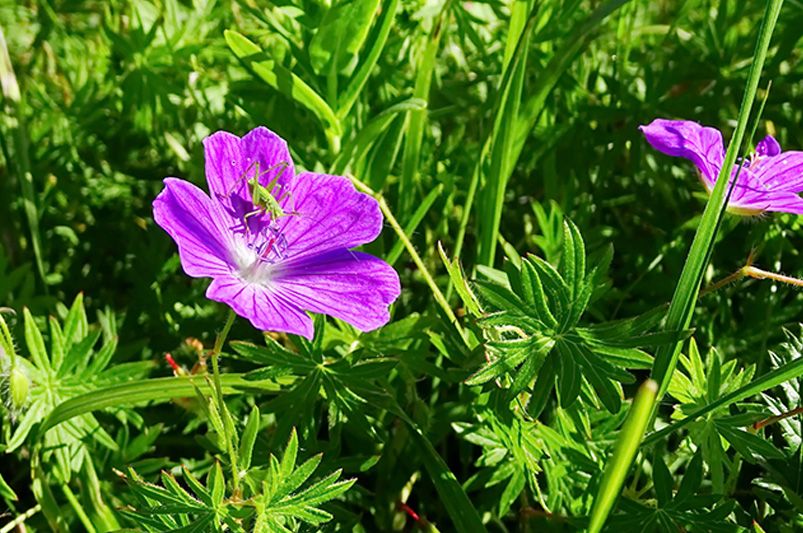
Tiny Monster Geranium
Tiny Monster Geranium is a very popular, hybrid variety of the genus. It is recognized and loved for multiple distinct characteristics. The plant:
-
Blooms with small clusters of pink flowers.
-
Blooms from spring until fall.
-
Has an interesting fall color where the foliage turns from green to purple-bronze.
-
Has a compact and low growth habit with a mature height between 6 and 12 inches and spread of 30-40 inches, making it perfect for ground covers.
-
Highly tolerant of various soil types and conditions (as long as the soil is well-draining).
-
Grows in USDA hardiness zones 4-11.
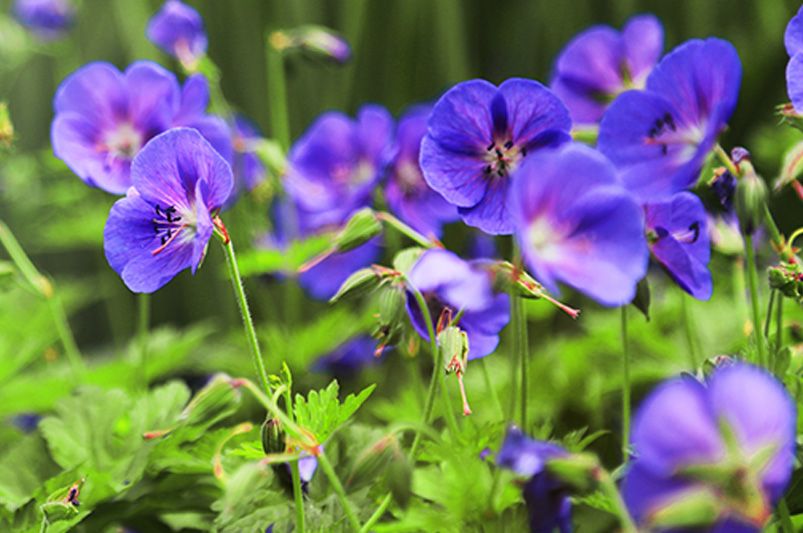
Wild Geranium
Last but not least, the Wild Geranium variety. Wild Geranium, also known as Geranium maculatum, is the classic, beloved variety of the genus. It:
-
Blooms with pink to purple flowers.
-
Blooms from April to June.
-
Attracts Pollinators like bees and butterflies.
-
has leaves that are deeply lobed and turn red in the fall.
-
Has a mature height of 18-24 inches and width of 12-18 inches.
-
Grows well in shady areas.
-
Grows in USDA hardiness zones 3-8.
You can find those lovely varieties in our Shrubhub garden shop here. While shopping, take advantage of our memorial day discount and gift a lovely plant to your friends, neighbors, or family. If you’re not sure what to choose, just go for our gift cards.
Conditions and Care
Now to take care of those perfect plants and have them grow in the healthiest, most vibrant shape, you need to know what you should provide for them. They’re low-maintenance, but those are things you should have in mind.
Plantation & Growth:
Geraniums do well in well-draining soil that is rich in organic matter. A loamy and well-aerated soil mix is ideal for these plants. Good drainage is essential to prevent waterlogging, which can lead to root rot.
Geraniums prefer full sun to partial shade. Choose a location that receives at least 6-8 hours of sunlight per day for optimal growth and blooming. Ensure proper spacing between plants to allow for good air circulation and prevent overcrowding. Space them according to the specific variety you are planting, typically about 12-18 inches apart.
Plant Care:
Water Geraniums deeply but infrequently. Allow the top inch of soil to dry out between watering sessions to prevent overwatering. Water at the base of the plant to keep the foliage dry and reduce the risk of fungal diseases.
Feed Geraniums with a balanced fertilizer, such as a 10-10-10 NPK formula, once a month during the growing season. Avoid over-fertilizing, as this can lead to excessive foliage growth at the expense of flowers.
In colder climates, Geraniums may need protection from frost. You can dig up the plants and overwinter them indoors in a cool, well-lit area. Alternatively, you can take cuttings to propagate new plants for the next growing season.
Pruning & Propagation:
Prune Geraniums lightly to maintain their shape and encourage bushy growth. You can trim back leggy or straggly stems to promote new growth and improve the plant's overall appearance.
Remove spent flowers (deadheading) regularly to encourage continuous blooming. Pinch off the faded blooms to promote new flower growth and keep the plant looking neat and tidy.
Propagation of Geraniums can be done through stem cuttings or by growing them from seeds. With stem cuttings, choose a stem that is about 4-6 inches long and has a few sets of leaves. Make sure it is not flowering and free from any signs of damage or disease. Prepare it then put it in a rooting hormone.
With seeds, plant them indoors about 8-10 weeks before the last frost date in your area. Fill seed trays or small pots with a seed-starting mix, moisten the soil, and sow the seeds on the surface. Provide proper conditions until time to transplant.
Common Pests & Diseases:
Common pests and diseases that can affect geranium plants include:
Aphids
Aphids are small, pear-shaped insects that feed on the leaves and stems of geranium plants. They can cause stunted growth, yellowing leaves, and distorted flowers. Aphids come in various colors such as green, yellow, brown, and black.
Spider Mites
Spider mites are tiny pests that feed on the undersides of geranium leaves, causing yellowing, stippling, and webbing.
Whiteflies
Whiteflies are small, flying insects that congregate on the undersides of geranium leaves. They can cause leaf yellowing, wilting, and a sticky substance called honeydew on the foliage.
Botrytis Blight
Also known as gray mold, Botrytis blight is a fungal disease that causes a grayish mold on the leaves, stems, and flowers of geraniums2. It thrives in cool and humid conditions and can lead to plant decline.
Powdery Mildew
Powdery mildew is a fungal disease characterized by a powdery white coating on the leaves and stems. It can cause leaf distortion and affect the overall health of the plant.
Bacterial Blight
Bacterial blight is a disease caused by the bacterium Xanthomonas campestris2. It leads to sunken spots on the leaves and wilting of the foliage while the stem remains firm. Infected leaves may turn grayish-brown and die off.
Leaf Spot
Leaf spot diseases, such as Alternaria leaf spot and bacterial leaf spot, can cause circular or irregular dark spots on the leaves of geraniums. These spots may enlarge and lead to leaf yellowing and defoliation.
This guide has gone into detail of our favorite Geranium varieties for you to choose your favorite and know your options. We also went through all the care you should provide and what you should look out for when you grow Geranium.
Taking care of your landscape and developing it is a life-long process. A joyful one. That is, if you're always developing and building on a strong foundation that you're happy with. However, if you have a problem with the fundamental design, then trying to change the plants or other small aspects would be like treating the symptoms rather than the problem.
If this is your case, then have no worries. At Shrubhub, we're currently offering a 70% discount on all our design services, including our 3D landscape design. You only need to sign up here and a professional designer from our team will contact you as soon as possible.


